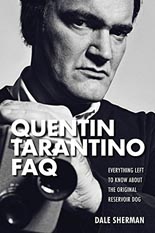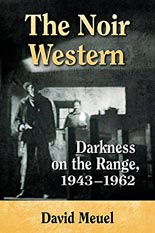 Don’t be dissuaded by the rather extended-pinky subtitle of B Is for Bad Cinema: Aesthetics, Politics, and Cultural Value, part of State University of New York Press’ ongoing “Horizons on Cinema” series. (Also don’t be dissuaded that Leos Carax’s critically revered Holy Motors adorns the cover; co-editors Claire Perkins and Constantine Verevis have some ’splainin’ to do regarding that curious choice, and try to in their introduction.) Available in both expensive hardcover and affordable paperback, this is a livelier-than-anticipated collection of intelligent essays addressing not-always-intelligent film. Nothing encapsulates the approach better than Jeffrey Sconce’s truly funny “Explosive Apathy”; if you never thought an academic piece would examine Hollywood’s physics-ignorant love of shooting characters walking toward the camera in slow motion as a fireball rages behind them, think again. Amid evaluations of William Friedkin’s notoriously (and arguably?) homophobic Cruising and Guy Green’s muddled Magus come works on botched subtitle translations, the technique of rear projection and the various DVD commentaries of Sam Raimi’s The Evil Dead. While the book’s concept remains not quite clearly delineated upon reaching the back cover, its contents are strong enough to survive without the overarching cohesion.
Don’t be dissuaded by the rather extended-pinky subtitle of B Is for Bad Cinema: Aesthetics, Politics, and Cultural Value, part of State University of New York Press’ ongoing “Horizons on Cinema” series. (Also don’t be dissuaded that Leos Carax’s critically revered Holy Motors adorns the cover; co-editors Claire Perkins and Constantine Verevis have some ’splainin’ to do regarding that curious choice, and try to in their introduction.) Available in both expensive hardcover and affordable paperback, this is a livelier-than-anticipated collection of intelligent essays addressing not-always-intelligent film. Nothing encapsulates the approach better than Jeffrey Sconce’s truly funny “Explosive Apathy”; if you never thought an academic piece would examine Hollywood’s physics-ignorant love of shooting characters walking toward the camera in slow motion as a fireball rages behind them, think again. Amid evaluations of William Friedkin’s notoriously (and arguably?) homophobic Cruising and Guy Green’s muddled Magus come works on botched subtitle translations, the technique of rear projection and the various DVD commentaries of Sam Raimi’s The Evil Dead. While the book’s concept remains not quite clearly delineated upon reaching the back cover, its contents are strong enough to survive without the overarching cohesion.
 Embarrassing as it is (especially when spoken aloud), the subtitle of Quentin Tarantino FAQ: Everything Left to Know About the Original Reservoir Dog rings true: There’s a lot I didn’t know about one of my favorite directors, and Dale Sherman has compiled an infinitely readable history of the man and his movies in a paperback package just shy of 400 pages. Last seen authoring another book in Applause’s FAQ series (2013’s Armageddon Films FAQ), Sherman fashions an honest-to-goodness narrative in Tarantino’s rise from high school dropout and video store clerk to multiple Academy Award winner and indie-film revolutionist. The road to his Reservoir Dogs debut is paved with far more stops than the “overnight sensation” label would have you believe, and the level of detail Sherman employs to tell that tale also is applied to the behind-the-scenes stories of each subsequent project. Also discussed: everything from grindhouse fare to Green Lantern — can you imagine Tarantino directing that? He considered it “for a second,” and fans will enjoy their hours spent reading this FAQ, excusing a few “royale” errors.
Embarrassing as it is (especially when spoken aloud), the subtitle of Quentin Tarantino FAQ: Everything Left to Know About the Original Reservoir Dog rings true: There’s a lot I didn’t know about one of my favorite directors, and Dale Sherman has compiled an infinitely readable history of the man and his movies in a paperback package just shy of 400 pages. Last seen authoring another book in Applause’s FAQ series (2013’s Armageddon Films FAQ), Sherman fashions an honest-to-goodness narrative in Tarantino’s rise from high school dropout and video store clerk to multiple Academy Award winner and indie-film revolutionist. The road to his Reservoir Dogs debut is paved with far more stops than the “overnight sensation” label would have you believe, and the level of detail Sherman employs to tell that tale also is applied to the behind-the-scenes stories of each subsequent project. Also discussed: everything from grindhouse fare to Green Lantern — can you imagine Tarantino directing that? He considered it “for a second,” and fans will enjoy their hours spent reading this FAQ, excusing a few “royale” errors.
 As David Meuel demonstrates throughout The Noir Western: Darkness on the Range, 1943-1962, more examples of this unusual marriage of shadows and saddle sores exist than I would have guessed. The McFarland & Company paperback gives Meuel — who penned Women in the Films of John Ford for the publisher last year — 11 chapters (not including intros and outros) to discuss representative works of “the dark cowboy.” Among them are such iconic Westerns as William A. Wellman’s The Ox-Bow Incident, Delmer Daves’ 3:10 to Yuma and Ford’s The Man Who Shot Liberty Valance; Meuel divides his essays thematically and/or by director, yielding pieces both knowledgeable and enlightening. The one digging into maverick Sam Fuller’s subversive contributions to the genre was my favorite, and stands as a great litmus test for any book browser considering taking the ride. I only wish the author had extended his scope beyond ’62, but at least his afterword acknowledges a post-date existence and influence. —Rod Lott
As David Meuel demonstrates throughout The Noir Western: Darkness on the Range, 1943-1962, more examples of this unusual marriage of shadows and saddle sores exist than I would have guessed. The McFarland & Company paperback gives Meuel — who penned Women in the Films of John Ford for the publisher last year — 11 chapters (not including intros and outros) to discuss representative works of “the dark cowboy.” Among them are such iconic Westerns as William A. Wellman’s The Ox-Bow Incident, Delmer Daves’ 3:10 to Yuma and Ford’s The Man Who Shot Liberty Valance; Meuel divides his essays thematically and/or by director, yielding pieces both knowledgeable and enlightening. The one digging into maverick Sam Fuller’s subversive contributions to the genre was my favorite, and stands as a great litmus test for any book browser considering taking the ride. I only wish the author had extended his scope beyond ’62, but at least his afterword acknowledges a post-date existence and influence. —Rod Lott

I do wish Tarantino’s brief ideas of directing a Friday the 13th and/or James Bond film had come to fruition. I’m liking all his stuff, but I’d love to see a horror film and spy film before he retires.